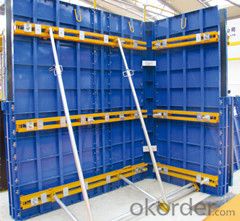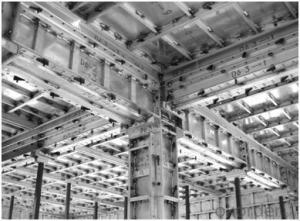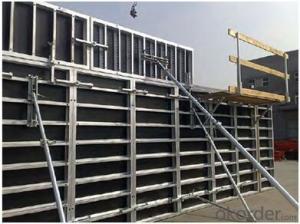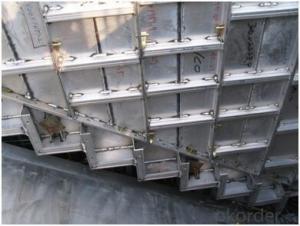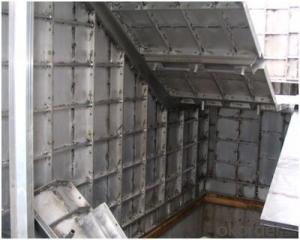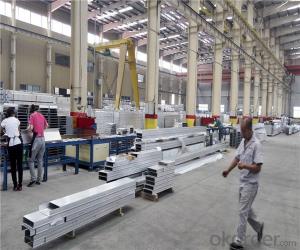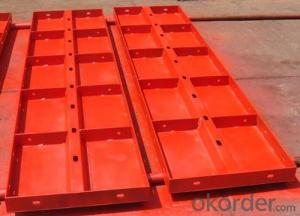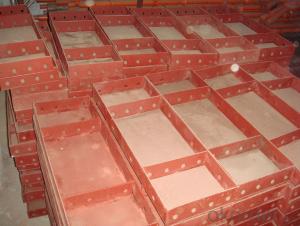Wholly Steel Formwork for Wall & Column with Customized Design
- Loading Port:
- China main port
- Payment Terms:
- TT OR LC
- Min Order Qty:
- 500 pc
- Supply Capability:
- 100000 pc/month
OKorder Service Pledge
OKorder Financial Service
You Might Also Like
Introduction for Steel Formwork :
Steel Formwork:used in highway,railway,bridge,tunnel and shearing wall,etc.Our company CNBM which is one of the largest State-Owned Enterprises in China which established in 1984 , has gained the confirmation from the specialist of China Architecture Scence Institute, and has been used by many building operation units and has been highly praised.In 2014, the total turnover volume of CNBM exceeds US$410 billion dollars with a total staff of 180,000. CNBM is listed in the World Top 500 Enterprises !
Characteristic for Wholly Steel Formwork :
1. High Smooth Surface
2. Convex ling for Edge Rib
3. Specialized Connection Pin for Edge Rib Connection
4. High Stiffness for Steel Surface
5. Light Weight for saving producing cost
6. Fast Separate and Easy transport
7. Recycling using
8. Scientific and Reasonable design to meet different working condition
Parameter and Specification :
Code | Size (mm) | Weight (KG) | Code | Size (mm) | Weight (KG) |
P12021 | 1200*2100*55 | 102.96 | P4018 | 400*1800*55 | 28.3 |
P12018 | 1200*1800*55 | 88.4 | P4015 | 400*1500*55 | 23.8 |
P12015 | 1200*1500*55 | 74.15 | P4012 | 400*1200*55 | 19.1 |
P12012 | 1200*1200*55 | 60.11 | P4009 | 400*900*55 | 14.6 |
P10018 | 1000*1800*55 | 76.01 | P4007 | 400*750*55 | 12.3 |
P10015 | 1000*1500*55 | 63.96 | P4006 | 400*600*55 | 9.95 |
P10012 | 1000*1200*55 | 60.11 | P3018 | 300*1800*55 | 20.7 |
P10009 | 1000*900*55 | 39.32 | P3015 | 300*1500*55 | 17.4 |
P9018 | 900*1800*55 | 70.89 | P3012 | 300*1200*55 | 14 |
P9015 | 900*1500*55 | 59.47 | P3009 | 300*900*55 | 10.7 |
P9012 | 900*1200*55 | 48.03 | P3007 | 300*750*55 | 8.8 |
P7518 | 750*1800*55 | 57.8 | P3006 | 300*600*55 | 7.3 |
P7515 | 750*1500*55 | 48.47 | P3004 | 300*400*55 | 5.46 |
P7512 | 750*1200*55 | 39.16 | P2515 | 250*1500*55 | 15.17 |
P7509 | 750*900*55 | 29.85 | P2512 | 250*1200*55 | 12.24 |
P7507 | 750*750*55 | 24.81 | P2509 | 250*900*55 | 9.32 |
P6018 | 600*1800*55 | 43.1 | P2507 | 250*750*55 | 7.71 |
P6015 | 600*1500*55 | 36.3 | P2506 | 250*600*55 | 6.39 |
P6012 | 600*1200*55 | 31.7 | P2015 | 200*1500*55 | 11.6 |
P6009 | 600*900*55 | 23.9 | P2012 | 200*1200*55 | 9.4 |
P6007 | 600*750*55 | 18.55 | P2009 | 200*900*55 | 7.1 |
P6006 | 600*600*55 | 16.25 | P2007 | 200*750*55 | 5.9 |
P5018 | 500*1800*55 | 36.27 | P2006 | 200*600*55 | 6.39 |
P5015 | 500*1500*55 | 30.15 | P2004 | 200*450*55 | 3.64 |
P5012 | 500*1200*55 | 25.55 | P1515 | 150*1500*55 | 9.5 |
P5009 | 500*900*55 | 20.38 | P1506 | 150*600*55 | 4 |
P5007 | 500*750*55 | 15.48 | P1504 | 150*450*55 | 2.98 |
P5006 | 500*600*55 | 13.58 | P1015 | 100*1500*55 | 7.5 |
Code | Size (mm) | Weight (KG) |
P1012 | 100*1200*55 | 6.9 |
P1009 | 100*900*55 | 4.6 |
P1007 | 100*750*55 | 3.8 |
P1006 | 100*600*55 | 3.1 |
P1004 | 100*450*55 | 2.33 |
E1515 | 150*150*1500 | 15.2 |
E1512 | 150*150*1200 | 12.26 |
E1509 | 150*150*900 | 9.34 |
E1507 | 150*150*750 | 7.77 |
E1506 | 150*150*600 | 6.46 |
E1504 | 150*150*450 | 4.87 |
E1015 | 100*150*1500 | 13.13 |
E1012 | 100*150*1200 | 10.61 |
E1009 | 100*150*900 | 8.07 |
E1006 | 100*150*600 | 5.44 |
Y1018 | 100*150*1800 | 14.56 |
Y1015 | 100*150*1500 | 12.29 |
Y1012 | 100*150*1200 | 9.72 |
Y1009 | 100*150*900 | 7.46 |
Y1007 | 100*150*700 | 6.19 |
Y1006 | 100*150*600 | 5.19 |
Y1004 | 100*150*450 | 3.92 |
J0018 | 50*50*1800 | 4.34 |
J0015 | 50*50*1500 | 3.7 |
J0012 | 50*50*1200 | 2.94 |
J0009 | 50*50*900 | 2.3 |
J0007 | 50*50*750 | 1.9 |
J0006 | 50*50*600 | 1.5 |
J0004 | 50*50*450 | 1.13 |
FAQ :
1. Who are we ?
We , CNBM , are a State-Owned Enterprise which established in 1984 , have 32 years experience ,enjoy high reputation .
2. Our Advantage :
Customized products , we have our own R&D department , we can design the drawing and suggest the suitable solution for your project .
3. Our after-Sales Service :
The international Sales Manager and Engineer can go to your job site for work direction and help you deal with your project .
Factory Photos :
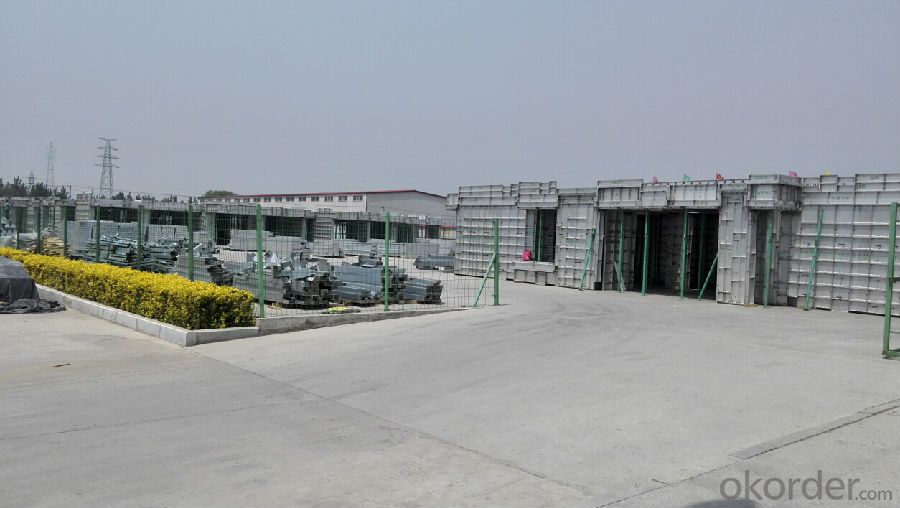
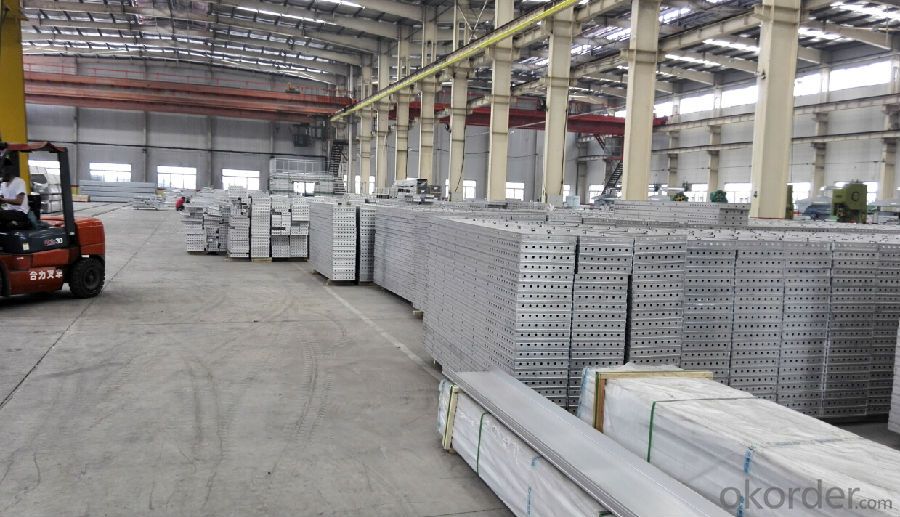
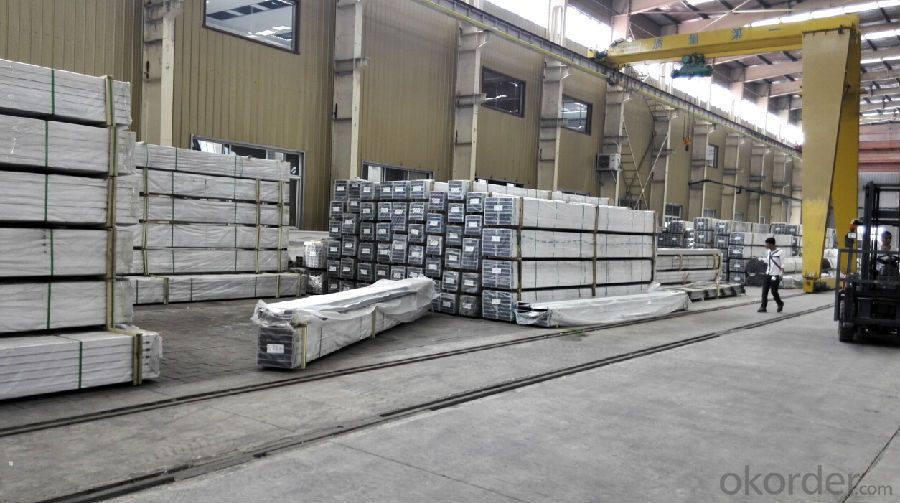

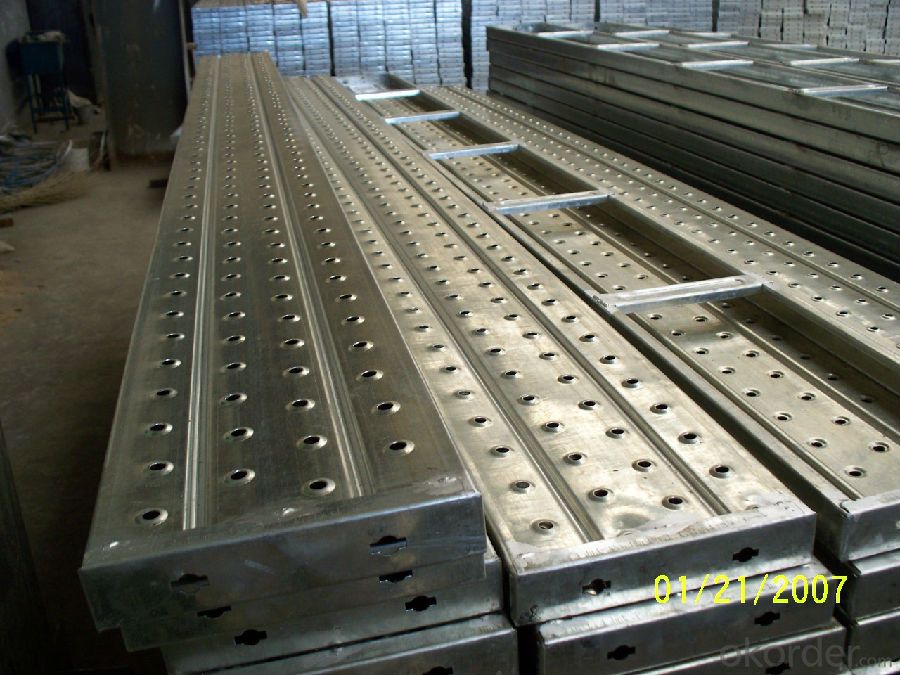
- Q: Can steel formwork be easily disassembled and removed after construction?
- Yes, steel formwork can be easily disassembled and removed after construction. Steel formwork systems are designed to be reusable and can be quickly disassembled by loosening bolts and removing the panels. This allows for efficient and cost-effective removal, making steel formwork a popular choice in construction projects.
- Q: What are the challenges of using steel formwork?
- There are several challenges associated with using steel formwork in construction projects. Firstly, steel formwork can be quite expensive compared to other types of formwork, such as timber or aluminum. This initial cost can be a deterrent for some contractors, especially those working on smaller projects with limited budgets. Secondly, steel formwork is much heavier than other types of formwork, which can make it more difficult to handle and transport on the construction site. This can lead to increased labor costs and slower construction progress. Another challenge is the limited flexibility of steel formwork. Unlike timber formwork, which can be easily cut and shaped to fit specific project requirements, steel formwork is rigid and less adaptable. This can be problematic when working on complex or irregularly shaped structures. Furthermore, steel formwork requires skilled labor and expertise to install and dismantle properly. Inexperienced workers may struggle with the assembly and disassembly process, leading to potential safety hazards and inefficiencies. Lastly, steel formwork requires regular maintenance to prevent rust and ensure its longevity. Over time, exposure to weather conditions and concrete can cause the steel to corrode, compromising its structural integrity. This maintenance work can add additional time and cost to the construction project. Despite these challenges, steel formwork can still offer several advantages, such as strength, durability, and reusability. It provides a smooth finish to concrete surfaces and can withstand high pressure loads. Ultimately, the decision to use steel formwork will depend on the specific requirements, budget, and expertise available for the construction project.
- Q: What are the common safety guidelines when working with steel formwork in hazardous areas?
- When working with steel formwork in hazardous areas, it is important to adhere to certain safety guidelines to ensure the protection of workers and prevent accidents. Here are some common safety guidelines to follow: 1. Personal Protective Equipment (PPE): All workers should wear appropriate PPE such as safety goggles, gloves, steel-toed boots, and hard hats to protect themselves from potential hazards. 2. Training and Education: Workers should receive proper training on how to work with steel formwork and be educated about the potential hazards associated with the specific hazardous areas they will be working in. This includes knowing how to handle steel formwork safely and understanding emergency procedures. 3. Hazard Identification and Risk Assessment: Before starting any work, a thorough assessment of the hazardous area should be conducted to identify potential risks and hazards. This will help in implementing appropriate safety measures and controls. 4. Fall Protection: If working at heights, proper fall protection measures should be in place, such as guardrails, safety harnesses, and safety nets. Workers should be trained on the correct use of fall protection equipment and systems. 5. Fire Safety: In hazardous areas, there may be an increased risk of fire. Ensure that fire extinguishers are readily available, workers are trained in their use, and emergency evacuation plans are in place. 6. Electrical Safety: Any electrical equipment or tools used in the vicinity of the steel formwork should be properly grounded and regularly inspected for safety. Workers should be cautious and avoid contact with live wires. 7. Proper Handling and Storage: When working with steel formwork, it is crucial to handle and store the materials properly to prevent injuries. This includes using appropriate lifting equipment, securing the formwork properly, and storing it in designated areas to avoid tripping hazards. 8. Adequate Ventilation: If working in confined spaces, ensure proper ventilation is in place to prevent the buildup of toxic gases or fumes. Workers should be trained on the signs and symptoms of exposure to hazardous substances. 9. Regular Inspections and Maintenance: Regular inspections of the steel formwork and surrounding areas should be conducted to identify any potential safety hazards. Any necessary repairs or maintenance should be carried out promptly. 10. Communication and Emergency Procedures: Clear communication should be established between workers, supervisors, and other stakeholders to ensure everyone is aware of the potential hazards and emergency procedures. Regular safety meetings and drills can help reinforce this communication. By following these common safety guidelines, workers can minimize the risks associated with working with steel formwork in hazardous areas and create a safer working environment.
- Q: What are the different types of steel formwork supports?
- Construction projects commonly employ various types of steel formwork supports. The following are some notable examples: 1. Adjustable Steel Props: Vertical supports that allow for height adjustment. They consist of steel tubes with an inner and outer tube that can be adjusted effortlessly. These props are often utilized to support horizontal formwork or scaffolding systems. 2. Soldier Formwork System: This type of support involves vertical steel members known as soldiers, which are evenly spaced along the formwork. The soldiers are engineered to withstand the lateral pressure exerted by wet concrete and provide support to the formwork panels. 3. Trench Struts: Trench struts are employed to stabilize and support formwork in trenches or excavations. They comprise steel tubes with adjustable length and are typically used alongside steel walers or beams to establish a robust framework for the formwork. 4. H-Frame Systems: Vertical formwork supports often rely on H-frame systems. These systems consist of interconnected steel frames shaped like an "H" to create a stable structure. They are frequently employed to support vertical formwork panels or serve as a framework for climbing formwork systems. 5. Steel Waler: A horizontal member utilized to support formwork panels. Steel channels or beams are commonly employed to construct walers. They are used in conjunction with vertical supports such as adjustable steel props or trench struts. These examples illustrate the variety of steel formwork supports widely employed in construction. The choice of support system depends on specific project requirements, including formwork design, load capacity, and desired adjustability.
- Q: What are the common challenges faced during steel formwork reassembly?
- Some common challenges faced during steel formwork reassembly include aligning and securing the individual components properly, ensuring the formwork is structurally sound and stable, dealing with any damage or corrosion on the steel components, coordinating with other construction activities to avoid delays, and ensuring proper safety measures are in place for workers involved in the reassembly process.
- Q: Types of building templates? What is clear water template?
- Plastic template: at present, there are many companies to develop a variety of plastic template, such as hard template, reinforced plastic wood plastic composite template, GMT plastic, plastic and plastic floor template template template system, reduce wood cutting, replacing the traditional technology with new technology, to believe that the future will widely used in building materials industry.
- Q: How does steel formwork affect the overall project cost?
- The overall project cost can be significantly affected by steel formwork. Comparatively, steel formwork is generally more expensive than alternatives like wood or aluminum. Nevertheless, there are various factors to consider when assessing the cost-effectiveness of using steel formwork. To begin with, the durability and longevity of steel formwork are well-known. Unlike wood, steel formwork can be reused multiple times, resulting in long-term cost savings. It requires less maintenance and repairs, which reduces the need for frequent replacements. This is particularly advantageous for projects involving repetitive use of formwork. Furthermore, steel formwork provides superior quality and precision in terms of concrete finishing. It offers a smoother surface and accurate dimensions, reducing the necessity for additional finishing work. Consequently, both time and money can be saved during the construction process. Additionally, steel formwork allows for faster construction compared to other types of formwork. It can be assembled and dismantled quickly, leading to faster turnaround times. This can positively impact the overall project schedule and potentially reduce labor costs. Moreover, steel formwork is more resistant to factors such as weather conditions, high pressure, and vibrations. This improves the structural integrity of the concrete, reducing the risk of defects and the need for rework. By minimizing the need for corrective actions, steel formwork can help control project costs. Nevertheless, it is important to note that the cost of steel formwork can vary depending on the size, complexity, and duration of the project. For smaller projects with limited use of formwork, the cost difference between steel and other materials may not be significant. In such cases, alternative formwork options may be more cost-effective. In conclusion, although steel formwork may have a higher upfront cost compared to other materials, its durability, precision, speed, and long-term reusability can result in cost savings throughout the project. It is crucial to carefully evaluate the specific requirements and circumstances of each project to determine the most cost-effective formwork solution.
- Q: Can steel formwork be used for soundproofing walls?
- Steel formwork is primarily used for creating the structure and shape of concrete walls during construction. While steel formwork is sturdy and durable, it is not specifically designed for soundproofing purposes. Soundproofing walls typically require materials with high acoustic performance and insulation properties to effectively block or absorb sound waves. While steel formwork may offer some level of sound reduction due to its density, it is not sufficient for achieving significant soundproofing results. To effectively soundproof walls, it is recommended to use specialized materials such as acoustic insulation, mass-loaded vinyl, or soundproof drywall, which are designed specifically for this purpose.
- Q: How does steel formwork prevent concrete segregation?
- Steel formwork prevents concrete segregation by providing a strong and rigid framework that holds the concrete in place during the pouring and curing process. This prevents the different components of the concrete mixture, such as aggregates and water, from separating and settling unevenly, resulting in a more homogeneous and uniform concrete structure.
- Q: Can steel formwork be used for tunnel construction?
- Yes, steel formwork can be used for tunnel construction. Steel formwork is commonly used in tunnel construction due to its durability, strength, and ability to withstand the pressures and forces exerted during the construction process. It provides a stable and secure framework for pouring concrete, ensuring the structural integrity of the tunnel. Additionally, steel formwork can be easily assembled and disassembled, making it a practical choice for tunnel construction projects.
Send your message to us
Wholly Steel Formwork for Wall & Column with Customized Design
- Loading Port:
- China main port
- Payment Terms:
- TT OR LC
- Min Order Qty:
- 500 pc
- Supply Capability:
- 100000 pc/month
OKorder Service Pledge
OKorder Financial Service
Similar products
Hot products
Hot Searches
Related keywords








